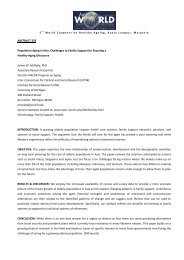The Pseudodementia Dilemma - 1st World Congress on Healthy ...
The Pseudodementia Dilemma - 1st World Congress on Healthy ...
The Pseudodementia Dilemma - 1st World Congress on Healthy ...
Create successful ePaper yourself
Turn your PDF publications into a flip-book with our unique Google optimized e-Paper software.
Organised by:<br />
Co-Sp<strong>on</strong>sored:<br />
Malaysian <strong>Healthy</strong> Ageing Society
<str<strong>on</strong>g>The</str<strong>on</strong>g> <str<strong>on</strong>g>Pseudodementia</str<strong>on</strong>g> <str<strong>on</strong>g>Dilemma</str<strong>on</strong>g><br />
Dr. Prem Kumar Chandrasekaran<br />
C<strong>on</strong>sultant Neuropsychiatrist<br />
Penang Adventist Hospital
C<strong>on</strong>tent<br />
• <str<strong>on</strong>g>Pseudodementia</str<strong>on</strong>g> – what is it?<br />
• Types<br />
• Evoluti<strong>on</strong> of the term<br />
• Current thoughts<br />
• Differential diagnosis & approach
Introducti<strong>on</strong><br />
• <str<strong>on</strong>g>Pseudodementia</str<strong>on</strong>g> a popular clinical c<strong>on</strong>cept<br />
• Refers to a group of disorders:<br />
1. Depressive pseudodementia<br />
2. Ganser’s syndrome<br />
3. Hysterical pseudodementia<br />
4. Simulated dementia<br />
• Sachdev et al (1990) validated the term by<br />
dem<strong>on</strong>strating l<strong>on</strong>gitudinally no diagnostic<br />
change (except 1) in cases of pseudodementia<br />
over a period of more than a decade
Depressive pseudodementia (DPD)<br />
• Some patients with depressi<strong>on</strong> do not exhibit<br />
hallmarks symptoms of depressi<strong>on</strong> - some S/S<br />
like psychomotor retardati<strong>on</strong>, anhed<strong>on</strong>ia,<br />
labored thinking, slipshod behavior, failing to<br />
register events, faulty orientati<strong>on</strong> and loss of<br />
recent memory should alert clinician to<br />
possibility of this category of pseudodementia<br />
• Kiloh (1961) described the above set of<br />
symptoms with additi<strong>on</strong>ally self-neglect and<br />
loss of weight<br />
• Post (1965) added those symptoms to<br />
observati<strong>on</strong>s of tremulous elderly patients<br />
with shuffling gait
DPD (c<strong>on</strong>’t)<br />
• Folstein and McHugh (1978) claimed both<br />
dementia and depressi<strong>on</strong> interact together<br />
and the term ‘pseudodementia’ a misnomer<br />
as cognitive deficits resolve when the<br />
depressi<strong>on</strong> resolves - suggested the term<br />
‘dementia syndrome of depressi<strong>on</strong>’<br />
• Could depressi<strong>on</strong> then be a reacti<strong>on</strong> to<br />
cognitive impairment in dementia? - Reifler<br />
et al (1982) felt that was so but <strong>on</strong>ly in mild<br />
and early cases of dementia
DPD (c<strong>on</strong>’t)<br />
• Jacoby and Levy observed larger ventricles in elderly<br />
depressives (1980) and decreased brain absorpti<strong>on</strong><br />
density (1983) as compared to c<strong>on</strong>trols – thus, ageing<br />
processes affecting the brain, i.e. cerebral neur<strong>on</strong>al<br />
loss and neurochemical c<strong>on</strong>comitants of depressi<strong>on</strong><br />
lead to cognitive failure<br />
• View strengthened by Abas et al (1990) of 70% of 20<br />
elderly depressives having cognitive impairment and<br />
up<strong>on</strong> recovery from depressi<strong>on</strong>, a third were still<br />
cognitively compromised - in line with thoughts of<br />
depressi<strong>on</strong> being a harbinger of dementia as elderly<br />
depressives were at increased risk of developing<br />
dementia (Post, 1962), as well as figures from Reding et<br />
al (1985) when more than half of 28 depressed and n<strong>on</strong>demented<br />
patients became demented 3 years later
DPD (c<strong>on</strong>’t)<br />
• Saez-F<strong>on</strong>seca et al (2007) found 71.4%of their<br />
182 patients suffering from DPD had c<strong>on</strong>vert<br />
into dementia at follow-ups as compared to<br />
<strong>on</strong>ly 18.2% in the cognitively intact group -<br />
c<strong>on</strong>cluded that reversible cognitive impairment<br />
in late-life moderate to severe depressi<strong>on</strong><br />
appeared to be a str<strong>on</strong>g predictor of dementia<br />
• Korczyn & Halperin (2009) rati<strong>on</strong>alized that<br />
since depressi<strong>on</strong> and dementia are both<br />
comm<strong>on</strong> in old age and frequently occur<br />
together, white matter changes both in<br />
Alzheimer’s disease (AD) and in depressi<strong>on</strong> were<br />
thought to reflect vascular changes, hence the<br />
c<strong>on</strong>cept ‘vascular depressi<strong>on</strong>’
DPD (c<strong>on</strong>’t)<br />
• However, c<strong>on</strong>sidering a marked increase in<br />
phosphorylated tau protein in CSF being<br />
indicative of AD, Blennow et al (1995) suggested<br />
that it serves as a positive biochemical marker to<br />
discriminate AD from DPD, as well as from normal<br />
ageing and Parkins<strong>on</strong>’s disease<br />
• Shinske et al (2008) felt it important to<br />
distinguish dementia from DPD because cogniti<strong>on</strong><br />
and memory disorder in DPD patients are<br />
treatable – they described a case of senile<br />
depressi<strong>on</strong> with the above symptoms and<br />
diagnosis by SPECT and PET findings of low blood<br />
flow and low metabolism in her fr<strong>on</strong>tal lobe,<br />
which normalised with improvement of<br />
depressive mood after antidepressant therapy
D/D Dementia and DPD (Small et al, 1981)<br />
Characteristics Dementia DPD<br />
History<br />
Precise Onset Unusual Usual<br />
Durati<strong>on</strong> of symptoms L<strong>on</strong>g Short<br />
Rapid symptom<br />
progressi<strong>on</strong><br />
Complaints of cognitive<br />
loss<br />
Descripti<strong>on</strong> of cognitive<br />
loss<br />
Family awareness of<br />
dysfuncti<strong>on</strong> and<br />
severity<br />
Unusual<br />
Variable (minimized in<br />
later stages)<br />
Vague<br />
Variable (usual in later<br />
stages)<br />
Usual<br />
Emphasised<br />
Detailed<br />
Usual<br />
Loss of social skills Late Early<br />
Psychopathology history Uncomm<strong>on</strong> Comm<strong>on</strong>
D/D Dementia and DPD (Small et al, 1981)<br />
Characteristics Dementia DPD<br />
Examinati<strong>on</strong><br />
Memory loss for recent vs.<br />
remote events<br />
Specific memory loss (‘patchy’<br />
deficits)<br />
Greater<br />
Uncomm<strong>on</strong><br />
About equal<br />
Comm<strong>on</strong><br />
Attenti<strong>on</strong> and c<strong>on</strong>centrati<strong>on</strong> Often poor Often good<br />
‘D<strong>on</strong>’t know’ answers Uncomm<strong>on</strong> Comm<strong>on</strong><br />
‘Near miss’ answers<br />
Performance <strong>on</strong> tasks of similar<br />
difficulty<br />
Emoti<strong>on</strong>al reacti<strong>on</strong> to<br />
symptoms<br />
Variable (comm<strong>on</strong> in later<br />
stages)<br />
C<strong>on</strong>sistent<br />
Variable (unc<strong>on</strong>cerned/shallow<br />
in later stages)<br />
Uncomm<strong>on</strong><br />
Variable<br />
Great distress<br />
Affect Labile, blunted or depressed Depressed<br />
Efforts in task performance Great Small<br />
Efforts to cope with dysfuncti<strong>on</strong> Maximal<br />
Minimal
Rx of DPD<br />
• Primary focus is to treat with<br />
antidepressants<br />
• Treatment of depressi<strong>on</strong> improved MMSE<br />
scores with a rise to normal scores 2<br />
years later in the ‘depressed/demented’<br />
group (Rabins et al, 1984)<br />
• Post (1965) and Burgeois et al (1970)<br />
found ECT to be especially effective in<br />
this group
Ganser’s syndrome<br />
• 1 st described by Ganser in 1897<br />
• Frequently, attenti<strong>on</strong> is <strong>on</strong> classic symptom<br />
of ‘vorbeireden’ or approximate answers or<br />
answering past the point, which Scott (1965)<br />
described as Ganser’s symptom and which is<br />
comm<strong>on</strong>er than the syndrome itself<br />
• However, this has led to other features<br />
being overlooked, i.e. prominent<br />
hallucinatory experiences (?pseudo),<br />
hysterical stigmata and fluctuating<br />
disturbance in c<strong>on</strong>sciousness
Ganser’s syndrome<br />
• Resoluti<strong>on</strong> is abrupt with complete and<br />
sometimes, residual amnesia (‘hysterical<br />
twilight state’) for the brief durati<strong>on</strong> of the<br />
illness, which Ganser (1898) himself believed was<br />
central to the presentati<strong>on</strong> and that approximate<br />
answers al<strong>on</strong>e is not enough to make a diagnosis,<br />
as many later papers that relied <strong>on</strong> that single<br />
symptom found it to lack specificity when use<br />
al<strong>on</strong>e<br />
• Mentor, Nissl, even believed it to be a<br />
manisfestati<strong>on</strong> of ‘catat<strong>on</strong>ic negativism’ and 1<br />
of Ganser’s 3 patients did in fact have catat<strong>on</strong>ic<br />
posturing as a feature
Ganser’s syndrome<br />
• <str<strong>on</strong>g>The</str<strong>on</strong>g> apparent dementia that accompanies approximate<br />
answers is usually incomplete, inc<strong>on</strong>sistent and selfc<strong>on</strong>tradictory<br />
• Patients are able to adapt to demands of daily life which<br />
those with organic dementia cannot<br />
• Motor behavior ranges from dazed stupor to histri<strong>on</strong>ic<br />
outbursts of excitement; mood ranges from apathetic<br />
indifference to anxious bewilderment<br />
• Whitlock (1967) called it the ‘buff<strong>on</strong>ery syndrome of<br />
schizophrenia’ from the associated c<strong>on</strong>fabulati<strong>on</strong> and<br />
childish, playful attitude. However, this betrays knowledge<br />
of the purpose of questi<strong>on</strong>s put forward and by the close<br />
approximati<strong>on</strong>, the correct answers may be available to the<br />
patient to an extent, although the answers seem absurd<br />
• Patients with this c<strong>on</strong>diti<strong>on</strong> exercise full deliberati<strong>on</strong> and an<br />
apparent serious intent<br />
• McGrath and McKenna (1965) felt the approximate answers<br />
were a ‘compromise’ stating “I am insane, yet sane”
Ganser’s syndrome<br />
• Can occur during the course of a depressive<br />
illness, head injury, early dementia, alcoholism<br />
and other toxic states and purely as a resp<strong>on</strong>se to<br />
emoti<strong>on</strong>al trauma<br />
• Organic and psychogenic factors operate together<br />
here<br />
• C<strong>on</strong>cept of gain led to the term ‘pris<strong>on</strong> psychosis’<br />
and although malingering can be suspected,<br />
noteworthy to menti<strong>on</strong> that patients do not<br />
provide sp<strong>on</strong>taneous absurd remarks; merely<br />
answers to questi<strong>on</strong>s they were asked
Ganser’s syndrome<br />
• In modern psychiatry, difficulty in interpreting much of this<br />
literature is the nebulous criteria used to define the<br />
syndrome<br />
• Enoch & Trethowan (1979) proposed a set of 4 criteria –<br />
approximate answers, clouding of c<strong>on</strong>sciousness, visual<br />
and auditory hallucinati<strong>on</strong>s and somatic c<strong>on</strong>versi<strong>on</strong><br />
symptoms<br />
• DSM-3 preserved the ‘repressi<strong>on</strong>’ of the syndrome’s<br />
‘hysteric’ character, enlisting it am<strong>on</strong>g factitious disorders<br />
together with Munchausen syndrome but the<br />
‘hysteric/dissociative’ character was later recognized by<br />
the newer diagnostic systems<br />
• Change in c<strong>on</strong>sciousness, as well as c<strong>on</strong>versi<strong>on</strong> symptoms,<br />
proof that this is a hysterical syndrome and not simple<br />
malingering<br />
• Thus, grouped under dissociative disorders in the DSM-4 (and<br />
-TR) and under other dissociative (c<strong>on</strong>versi<strong>on</strong>) disorders in<br />
ICD-10
Hysterical pseudodementia<br />
• C<strong>on</strong>versi<strong>on</strong> pseudodementia in older people<br />
caused by catastrophic reacti<strong>on</strong> to cumulative<br />
loss in later life in individuals with predisposing<br />
borderline and narcissistic traits (Hepple, 2004)<br />
• Mechanisms of hysterical dissociati<strong>on</strong> may<br />
operate to some degree in pseudodementias<br />
• Likewise, covert affective disorders may<br />
c<strong>on</strong>tribute to hysterical pseudodementia<br />
• Also occurs in those with compromised<br />
intelligence<br />
• Syndrome is more comm<strong>on</strong> in women from higher<br />
socio-ec<strong>on</strong>omic background with past psychiatric<br />
histories dominated by depressive symptoms
Hysterical pseudodementia<br />
• Core features - apparent cognitive<br />
impairment, regressi<strong>on</strong> and increasing<br />
physical dependency<br />
• Other symptoms - classical sensory loss,<br />
paralysis and ‘belle indifferance’ of<br />
c<strong>on</strong>versi<strong>on</strong><br />
• <str<strong>on</strong>g>The</str<strong>on</strong>g>re can be fatuous cheerfulness or<br />
sullen apathy and in severe cases,<br />
hysterical puerilism, infantilism and<br />
amnesia
Hysterical pseudodementia<br />
• Treatment using psychotherapeutic<br />
approaches may limit the progressi<strong>on</strong> of<br />
the syndrome if recognised at an early<br />
stage<br />
• Role of abreacti<strong>on</strong> and sleep deprivati<strong>on</strong><br />
was described by Patrick and Hommels<br />
(1990), who c<strong>on</strong>versely found that<br />
c<strong>on</strong>fusi<strong>on</strong> was exacerbated with those<br />
modalities in patients having organic<br />
dementia
Simulated dementia<br />
• Memory loss appears to be an isolated main<br />
symptom<br />
• <str<strong>on</strong>g>The</str<strong>on</strong>g>re could also be mutism and lack of<br />
cooperati<strong>on</strong><br />
• Anders<strong>on</strong> et al (1989) failed to get 18 psychology<br />
students to c<strong>on</strong>vincingly feign dementia – with<br />
repeated efforts, fatigue set in and they<br />
experienced a ‘pull <strong>on</strong> reality’<br />
• Hunt (1973) used the MMPI to distinguish<br />
malingerers from subjects with organic dementia<br />
as the series of questi<strong>on</strong>s were designed to weed<br />
out inc<strong>on</strong>sistencies<br />
• Kraupl-Taylor (1966) observed the malingerer got<br />
anxious and upset when slips pointed out
Simulated dementia – D/D<br />
• Point in differentiating those simulating<br />
dementia - they appeared to be more<br />
‘superficial’ than patients with Ganser’s<br />
syndrome<br />
• Increase in c<strong>on</strong>scious malingering and the<br />
course of the disorder is l<strong>on</strong>ger and<br />
relapsing<br />
• Absence of melancholia present in DPD
D/D from Functi<strong>on</strong>al disorders<br />
• Sometimes, functi<strong>on</strong>al disorders have dementialike<br />
symptoms and in hypomania, distractibility<br />
and random answers can mimic disorientati<strong>on</strong><br />
and failing memory; playfulness could lead to<br />
false replies<br />
• Carney (1983) observed manic overactivity can be<br />
mistaken for agitati<strong>on</strong><br />
• In schizophrenia, poverty of ideas, emoti<strong>on</strong>al<br />
blunting and an unkempt state may suggest<br />
dementia<br />
• Misleading the clinical picture is presence of late<br />
paraphrenia (Roth, 1981) and dem<strong>on</strong>strati<strong>on</strong> of<br />
the presence of mild cognitive disorder and<br />
enlargement of ventricles (Naquib and Levy,<br />
1987)
C<strong>on</strong>clusi<strong>on</strong>s<br />
• <str<strong>on</strong>g>Pseudodementia</str<strong>on</strong>g> is a very real entity of<br />
disorders<br />
• Importance in recognising DPD as it is<br />
treatable<br />
• Clinicians needs to be aware of impact of<br />
hysterical c<strong>on</strong>versi<strong>on</strong> in pseudementias<br />
• Differentiating simulated dementia may<br />
identify malingerers
Thank You<br />
Main source:<br />
Lishman WA: Organic Psychiatry - <str<strong>on</strong>g>The</str<strong>on</strong>g> Psychological C<strong>on</strong>sequences of<br />
Cerebral Disorder (3 rd Editi<strong>on</strong>). Blackwell Science, 1998















